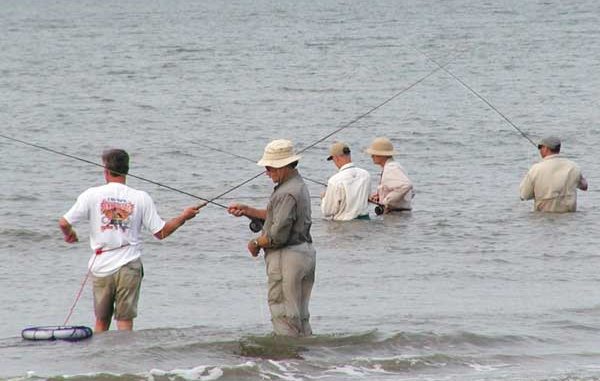
There’s no need to take a long run to catch all the speckled trout you could ever want.
Summer’s here. Surf’s down, dudes!
As summer goes on, the surf along the entire Gulf of Mexico becomes more consistently calm. That is, until tropical storms enter the picture. Since that’s not likely until August, seize the days and make them count.
In June, the surf at Grand Isle can offer some really nice speckled trout on fly rod. I’m talking about fish up to 3 pounds, possibly larger.
The caveat is that there are an equal number of days this month where the wind blows 15 knots or more. It takes even less wind than that for the island, which runs northeast to southwest, to dirty up from a southwest wind.
Mid-summer offers more trout and a wider variety of species. The other species include redfish, sand trout, pompano, Spanish mackerel, bluefish, jacks and ladyfish, to name a few. Sometimes you never know what will show up.
My friend Pete Sturgis had a very brief encounter with a king mackerel a couple of years back. Then there was that tarpon that Mike LaFleur sighted, and a cobia that was landed near the Fourchon barges.
Pete and Mike are members of our local fly club here in Baton Rouge. Things have sure changed from when our club made its first group trip to Grand Isle some 16 years ago. Many of us have evolved into very successful surf anglers thanks to experimentation of flies and techniques, and information shared among members. It’s one of the advantages of being in a fly fishing club.
For the last five years, members of other Louisiana clubs, along with a couple of clubs from Mississippi, have united with ours into one large outing. It’s regularly scheduled the weekend in July just before the Grand Isle Tarpon Rodeo.
The “Grand Isle Fly Fishing Weekend” finds the island innudated with fly rodders.
There are dozens of flies that work in the surf, and at least a dozen techniques for fishing them. Often it only requires one fly, one technique to catch fish.
The advantage of having many bodies present at any one time is that we can all try different flies and techniques at once to determine which fly or technique the fish demand.
One strategy is to get together in small groups and each tie on a different fly. Then we spread out into a given area. When one rod is bent consistently, we all know what fly that group member had on, and promptly switch to that fly.
Here’s a few proven techniques that are often first or second choices among group members.
For surf fishing, we use 8- to 9-foot leaders, supple and thin in the butt, so they sink fast. Thin leaders also detect strikes better. Fluorocarbon is a good choice here, but not necessary.
You can also get the leader to sink fast by adding a sink-tip section between fly line and leader.
One new product that turns flies over well, and yet retains suppleness, is furled leaders. These are available from any fly shop. If you have trouble casting long, thin leaders, then I suggest using a furled leader with about a 2-foot tippet.
If the surf is choppy, we put the floating line away and use an intermediate line to cut through the waves.
Intermediate lines that are clear — so-called slime lines — are also a good choice when water is crystal clear. Believe it or not, there are times in late summer when this condition exists at Grand Isle. That’s when you really appreciate slime lines.
Without question, the No. 1 surf fly is the Clouser Minnow, either in chartreuse/white or purple/white.
Other speck killers include: Surf Candy, Whitlock Baitfish, the Lefty/Clouser Half & Half, LaFleur’s Charlie and Marc Pinsel’s 4M.
I’ve also had great success with the 4M on pelagic species. Throw it to a jack crevalle, and you best be prepared to wear out your arms bringing him in!
By now you’ve probably noticed something missing in my repertoire. I saved the best for last. If conditions are calm, you MUST try a popper. Watching fish in the surf hit poppers is certainly fun enough, but as any speck expert will say, topwaters are also the preference for BIG specks.
Some favorites include like Kirk’s Popper, Bob’s Banger, the Skipping Bug and flies with a prop, like Jim Stewart’s Buzz Bug or Kevin Cormier’s Torpedo Fly. Flies with props are very difficult to cast, but are noisy and thus attract fish.
The effectiveness of topwater flies in the surf was illustrated again last summer. My friend Gary Peterson was out just before dawn, in knee-deep water, casting a Gartside Gurgler and giving it a slightly erratic retreive.
Suddenly the water blew up around the fly, and line started zipping through his guides and fingers. After about 15 minutes, a 5+-pound speck was put to the net.
Gary wasn’t expecting a fish this size, but he was expecting fish. A veteran surf angler, he knows the things to look for: slicks, diving birds, riptides moving out, schools of baitfish or shrimp skipping about on the surface, just to name a few.
He recently reminded me of why surf fishing turns him on.
“You’re in the fish’s domain, where he also has that extra vigor,” he said. “That 5-pound speck fought harder than a redfish twice his size.”
That’s pretty much all I needed to hear. Grand Isle, here I come!